SUSTAINABLE DIRT
Dirt is Free, Almost
Sustainability is such a buzzword these days. Okay, I’ll join the crowd and say, “I’m growing fruits and vegetables sustainably.” But is this true. Can they really be grown sustainably, that is, in such a way to be able to continue forever?
As any plant grows, it sucks nutrients from the soil. Harvest the plant and you take those nutrients off-site. Eventually, those nutrients need replenishment. That’s what fertilizer does, but spreading fertilizer — whether organic or chemical — is hardly sustainable. Organic fertilizers, such as soybean meal, need to be grown, harvested (taking nutrients off site), processed, bagged, and transported. Chemical fertilizers need to be mined and processed, or manufactured, and then also bagged and transported.
About half the volume of most soils is mineral, the rest being air, water, and organic matter. The mineral portion derives from rocks that, with time, temperature changes, and the jostling and chemical action of plant roots, fungi, earthworms, and other soil microorganisms, are ground finer and finer. Plant nutrients once locked up in those rocks become soluble and available to plants. Over time, a soil naturally offers a pretty much unlimited supply of plant nutrients. That sounds sustainable . . . but wait; three important caveats.
First, it takes time to release those nutrients. Remove too much too fast and it’s like taking money out of the bank faster than you put it in.
Second, one very important nutrient, nitrogen, does not come from rocks. It comes from the air, “fixed” by soil microorganisms, then incorporated into plants. As plants die, the nitrogen is incorporated into the organic fraction of the soil, from which it is slowly released into the ground for other plants to use — unless it washes away or becomes a gas again. Nitrogen is the most evanescent of plant nutrients.
And third, a soil could be naturally lacking in one or more essential plant nutrients. If so, the deficiency needs to be corrected by bringing in and spreading what’s needed.
Hay, Time, & a Little Manure
Okay, here’s my stab at sustainability: My vegetables get “fed” only compost, a one-inch depth laid on top of each bed each year. This much compost releases enough nitrogen, as well as other nutrients, to keep plants happy and healthy for a year.
But the sustainability meter must examine what goes into the compost. The bulk of my compost is made from hay harvested from my one acre hayfield. Here’s the rub: If I harvest the hay too frequently, I’m mining the soil, pulling out nutrients faster than they are naturally replenished. So I focus on different parts of the field in different years, giving previously harvested portions time to rejuvenate.
Early morning forays into the field with my scythe provide enough hay for compost making during the growing season. Last week, I did what I do each fall, attaching the brush hog to my tractor and mowing the whole field. (Mostly, this prevents the field from morphing over time, first to a field of brambles, multiflora roses, and autumn olives, and then on to forest.) After brush hogging, I rake up a few clumps of hay here and there for the final “feeding” of the season’s compost piles.
This end-of-season stuff is not very nutrient-rich, so what little I harvest takes little from the field in terms of nutrients. This cutting mostly supplies carbon compounds, which it got from via photosynthesis from carbon dioxide, to feed the compost microorganisms.
Keeping an eye on the character of the hayfield should give me some idea of how it’s doing nutritionally. More grasses, more nutrients. Areas of goldenrod, yarrow, and other forbs get mowed, but not raked.
My compost pile also gets fed horse manure that I haul in from a local stable. My use of manure is sustainable only in the sense that it’s someone else’s waste product. Other additions to my compost pile are kitchen scraps and spent garden plants (which recycles rather than adds nutrients), and old blue jeans and other biodegradable clothing. Using humanure (see The Humanure Handbook by Joseph Jenkins), if I had a composting toilet, would further close the nutrient cycle.
Two final additions, sustainable except that they need to be transported here, are ground limestone and kelp. The limestone holds soil acidity near neutral, which, among other benefits, puts nutrients in forms most accessible to plants. The kelp, replete with a spectrum of micronutrients, is for insurance, just in case my soil naturally lacks any essential plant (or human) nutrient.
And Now for the Cart’s Sustainability
Hay is bulky stuff; same goes for manure. I move all that bulky stuff to my compost piles, then move the finished compost away from the piles. All this moving is done with the help of my “Vermont garden cart,” which has two heavy duty, bicycle-sized tires sitting just about midway across a sturdy plywood bed surrounded by three sturdy plywood walls. Although the cart can haul up to 400 pounds, shoveling out manure or compost scrapes away at the plywood base. That, along with jabs from the pitchfork as I pile in hay severely compromised the wood . . . until this summer.
A sheet of aluminum, a friend’s brake for making sharp bends in the sheet, and some screws, and I had the bottom of the cart, and a few inches up each side, protected from my shovel, pitchfork, and moisture. These carts should be sold already aluminized.
The only problem is that aluminum is very unsustainable. Although abundant, enormous amounts of electricity are required to free it from the raw material, bauxite. On the plus side, aluminum is very long-lasting; I’ll never have to replace it in my carts.

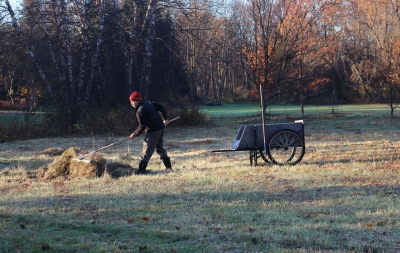
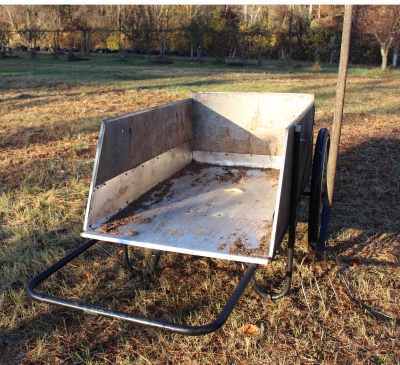
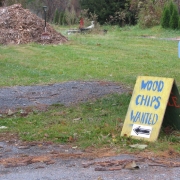
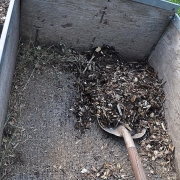
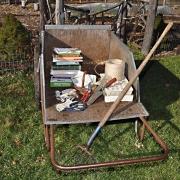

Hi Lee,
I’m a little north of you in Woodstock. Thank you for your blogs. I learn a lot from them! I was wondering what your thoughts on cover crops are. Last fall in a couple of my garden beds I planted buckwheat or a combination of pea/oats – the claim being – to choke out weeds, fix nitrogen, increase organic matter, etc…not sure the weeds were choked out…should I bother if I follow your composting advice?
Thanks,
Marla
I sometimes do use cover crops although, in all honesty, I’ve never seen a benefit the following season (except that I like the way it looks going into fall and winter). Perhaps because of all the compost I use. The ideal would be for a cover crop to replace some of the compost. Still, I recommend doing both: composting and cover cropping. By the way, buckwheat is a warm weather cover crop sown during summer months.
Lee, really enjoy your blog and the information you provide! Can you recommend a text book regarding soil that can be understood by a novice that is factual and current?
My book WEEDLESS GARDENING has a lot of solid soil information. BUILDING SOILS FOR BETTER CROPS by Fred Magdoff is also good. More in depth is Brady and Weil’s THE NATURE AND PROPERTY OF SOILS.
Fred Magdoff Building Soil is free as a PDF download from SARE http://www.sare.org/Learning-Center/Books/Building-Soils-for-Better-Crops-3rd-Edition
I just startet to read your “weedless gardening” book and I´ll give the “no till approach” a go on the additional veg bed we plan for next season.
We already use a lot of homemade compost in the vegetable garden, but always sift it, which is a lot of work. Do you skip sifting – its not mentioned in your book?
Greetings from Germany,
Christiane
Funny you should ask. Last year I started to build a tremble type sifter. Partway into the project, I realized that my compost is sufficiently broken down that it does not need sifting. Forking it or shoveling it, breaking apart an occasional clump, is all it needs. Mostly, I spread compost in fall, and the action of freezing and thawing through winter further breaks it up. I successfully sow carrots and other small seeds right into the compost. I do, however, sift the compost that I use in making potting mixes; I also sift the whole mix, in either case using a frame with 1/2″ hardware cloth.
Thank you, Lee.
I will try the soon-to-come “no-dig-bed” with non- sifted compost, too, then. A few weeks go I shoveled one of our compost bins onto the other (both beeing as good as ready) to make room for the new stuff. Loosening the compost with a “Krail”. Back then a tought it might as well be enough to pick out a few left over larger twigs than to sift the stuff.
Thanks for your answer!
Great article. I shared it on my page, Prodigal Earth.
A few thoughts, based on my understanding of the work of soil scientist Dr Elaine Ingham.
1. All soils already contain the full spectrum of nutrients that any plant could ever need, and in basically inexhaustible quantities. They are found in the sand, silt, and clay that make up the inorganic portion of every soil in the world. This info is available in any basic soil science textbook. The problem is that many of these elements are tied up in non-plant-available compounds.
2. The primary benefit of adding good compost to your garden is not the nutrients that you’re “mining” from your hay field, but rather the introduction of large quantities of beneficial aerobic soil microbes that actually do mine the soil and convert it into plant-available compound.
3. The kicker is that you’ve got to have the full spectrum of these organisms in your soil (and compost) in order for nutrient cycling to occur. The bacteria and fungi that break down both organic and inorganic matter do not just release it in plant-available form, at least not in the quantities your plants need. You need all of the predatory species that eat bacteria, fungi, and one another. Their waste is what feeds the plants. If your soil is showing deficiencies in a given nutrient, that’s a sign that some organisms are missing from this soil-food web. Adding lime and other amendments won’t be nearly as effective as simply getting those organisms in place.
4. It’s all about the balance of bacteria to fungi. Different plants prefer different ratios, and all plants will do better the higher you can get those numbers while maintaining the right ratio. Bacteria-dominated soils will be basic, due to the compounds released by bacteria. Fungal-dominated soils will be acidic, due to the acidic compounds released by fungi. So to change the balance, you need to change the ratio, rather than add emendments like lime (which apparently only affects soil pH for a matter of weeks).
5. The only reliable way to know what organisms are present or absent in your soil is by having someone who knows what they’re looking at examine your soil under a microscope. This needs to be more than a simple bacterial or fungal count, as this doesn’t differentiate between aerobic and anaerobic (disease-promoting) species. You need to know what kinds of and how many nematodes, protozoa, amoebae, cilliates, etc. You can either send away soil and compost samples to someone else to do this, or get a microscope and learn how to do it yourself.
5. Short of #4, the next best thing is to watch for diversity at the higher levels of the soil-food web. Earthworm numbers are a good indicator, for instance.
All of this is what I’ve heard and read from Dr Ingham, and I’m relying on her authority and experience. I have seen good results in my garden, applying her methods, and I’m trying to learn how to use the microscope to ID microbes. Eventually I hope to take one of her classes.
Anyway, I just thought I’d share her take with you here and see what you think.
Cheers!
It is helpful to see more of how you grow, but I’d take issue with the idea of the kelp as “sustainable.” Several studies (see below) have shown that seaweed harvesting causes significant habitat loss for important stocks as well as other issues. Hopefully you can shed some light on that and correct me if I’m wrong.
I’d also been under the impression that your compost was all from on-site materials. Wouldn’t composted horse manure or kelp alone provide all the nutrients you need? Similarly, wouldn’t composting all your kitchen and garden waste do the same?
Kelp harvesting studies/references:
http://www.scientificamerican.com/article/help-for-kelp-seaweed-slashers-see-harvesting-cuts-coming/
Referring to Maine’s beds: “Rockweeds are long-lived and habitat forming,” Seeley says. “These plants persist for centuries. They’re the underwater old-growth forest.”
http://conservationmaven.com/frontpage/the-ecological-consequences-of-industrial-kelp-harvesting.html
https://science.nature.nps.gov/im/units/medn/monitor/kelpforest.cfm
Thanks for the good information. I’ll read up about kelp. The horse manure would provide a lot of nutrients but as far as a full spectrum in adequate amounts, it would depend on what the horses were fed. Kitchen and garden waste aren’t enough to make all the compost I need. I’d probably need a bigger hayfield to be able to make enough compost for my garden. This is something I’m looking into: The ratio of hayfield to cultivated land to be able to use the hay to sustainably replenish nutrients and maintain or increase organic matter content of the cultivated ground.
I read those references. I guess the key is using seaweed that has been sustainably harvested. Also, since I use seaweed only for micronutrients, only small amounts are needed. In fact, because my compost is made form such a wide spectrum of materials, rationally, I probably don’t need to use any seaweed. I’ve used it as insurance. Knowing that it’s threatened, I may rethink that.
Thank you for taking the time to respond.
The links I sent were just the first ones that came up in Google, but they are representative of the other items I’ve read on the topic.
Thank you also for considering whether the seaweed is really necessary. As with so many things in life, and in the garden, I think many of us (myself included) simply do things because that’s what we’ve always done, and it worked. Now we’re all learning about ways to do better, and I have certainly learned a tremendous amount from your work – thank you.